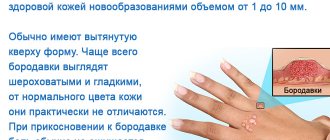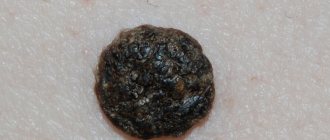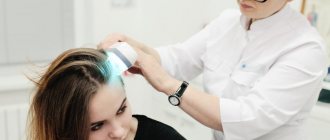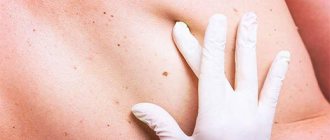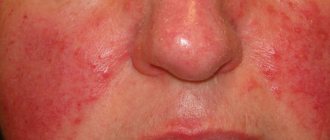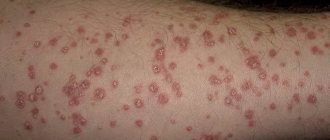After some time, they are filled with a light, slightly cloudy liquid. In addition, the patient experiences fever, weakness, and headache. To treat chickenpox, topical use of brilliant green, antiseptics and antipyretics are prescribed. Measles is manifested by the appearance of small spots on the body and inflammation of the mucous membranes. The rash gradually descends to the lower extremities, some of the spots are filled with liquid. Sometimes measles can be mixed with rubella and scarlet fever.
Other diseases
If red spots appear on the body, this may signal the occurrence of serious disturbances in the functioning of the body. Acute hepatitis and pancreatitis manifests itself in the form of an abundance of small red spots resembling moles.
Syphilis and immunodeficiency diseases are also accompanied by the appearance of skin rashes.
Bright red vascular spots (see photo) - hemangiomas - benign tumors. They are practically harmless, but they spoil the appearance.
The skin is the organ that first of all signals problems in the body. The general state of health and the condition of the skin are always closely related - this is a scientifically proven fact. Very often, a symptom of a particular disease is the appearance of red spots on the skin.
Rashes on the body do not always indicate dangerous conditions that pose a threat to life. They can appear after suffering stress or after prolonged emotional stress and will go away on their own when the person calms down. However, in some cases, red spots indicate diseases that require immediate medical attention.
The content of the article:
Stress and disruptions in the nervous system
Severe emotional shocks, psychological and physical stress can lead to the appearance of a rash. As a result, a person develops vegetative-vascular dystonia, the functioning of the sympathetic and parasympathetic systems malfunctions, and vascular tone suffers. This certainly affects the condition of the skin with the appearance of red spots. They can remain on the dermis for quite a long period of time.
Red spots on the body are often the result of allergic reactions. They can be a symptom of urticaria or an allergy to cold, that is, they appear immediately after contact with the allergen. Sometimes spots appear in response to a delayed allergic reaction.
To establish the allergic nature of the rash, other symptoms of the disease, for example, itching, should be assessed. It should be understood that immediate allergic reactions can be very dangerous to human health and even life, and therefore require qualified medical care.
Allergic diseases that have a chronic course provoke the appearance of skin rashes in the form of spots. These are pathologies such as atopic dermatitis and eczema. At the same time, even minor errors in nutrition or the penetration of allergens into the body through the skin can provoke an exacerbation of the disease. The appearance of new rashes is always accompanied by severe itching.
Infectious diseases
For the doctor, the nature of the spots, their location and appearance are of great importance. Often, one glance at a skin rash is enough for a specialist to suspect a particular disease. The nature of the spots will differ for mycotic, viral and bacterial infections.
Viral diseases
In diseases such as measles, rubella and chickenpox, the appearance of spots on the skin is the first symptom of infection. In each case, isolation of the patient is necessary in order to prevent the development of a mass outbreak of a viral disease. That is why a timely examination by a doctor and making a correct diagnosis is so important.
Characteristic features of rashes due to various viral infections:
With measles, spots first fill the face, then the rash begins to “sink” onto the body. In parallel with this process, rashes filled with liquid appear.
The red spots that appear with rubella begin to peel off and become crusty after 3 days. Their favorite places to localize are the extensor surfaces of the arms and legs, as well as the body. If you press on the elements of the rash, they turn pale.
Those rashes that appear with chickenpox very quickly form vesicles and pustules. Chicken pox causes rashes all over the body.
In adulthood, chickenpox manifests itself with other symptoms.
Diseases caused by bacteria
Streptococcus is more likely than other bacteria to cause spots on the skin. This dangerous microorganism causes diseases such as scarlet fever, erysipelas and streptoderma.
The location of the spots and their nature are strictly specific for each bacterial infection. In addition, they all have additional features. For example, with scarlet fever, the rash is always accompanied by a sore throat.
Fungal skin diseases
With fungal infections, red spots often appear on the skin. Sometimes they accompany a disease such as candidiasis, which is widespread. If rashes appear on the skin with thrush, this indicates a generalized form of infection and indicates a deficiency of the patient’s immune system.
Ringworm is accompanied by the appearance of red, scaly spots on the skin. The fungus affects the scalp, but it is possible that it can be found in other parts of the body.
Red spots as a dermatological problem
The appearance of red spots is also explained by certain disorders in the skin itself, that is, their formation is associated with dermatological diseases.
These include:
Eczema.
This disease is a specific reaction of the body to chemical components in cosmetics, household chemicals, and food.
Eczema often becomes chronic, and acute and fatty foods, stress, insect bites, and unfavorable weather conditions can trigger an exacerbation.
Eczema manifests itself as bubbles located against the background of hyperemic skin.
Depending on the type of disease, the top of the spot may be covered with scales and crusts, after removal of which a weeping surface remains.
Photodermatosis.
Increased sensitivity of the skin to ultraviolet rays.
Sun exposure on exposed areas of the body can cause pinpoint rashes, limited redness and swelling.
Atopic dermatitis.
It can happen in both infants and adults. Manifestations of the disease on the skin are varied. These include hyperemia with the appearance of an allergic rash, read more here https://allergiik.ru/atopicheskij-dermatit.html.
Redness and itching of the skin in atopy often worsens after water treatments.
Psoriasis.
It appears as red spots in the extensor areas of the body, such as the knees, elbows, lower back, and buttocks.
Individual red plaques can merge with each other, and their surface is covered with yellowish scales.
POPULAR WITH READERS: Allergy to parrots, signs, symptoms, treatment
Psoriasis is a disease that is practically untreatable.
Seborrhea.
In severe forms of this disease, red spots with a scaly surface appear on the skin of the forehead, behind the ears, and on the scalp. The spots itch and tighten the skin.
A parasitic rash on the red body is caused by scabies mites and demodex mites.
With scabies, the rash first appears on the arms, stomach, and then spreads throughout the body.
Demodicosis is manifested by the appearance of reddish pimples on the face, which can then spread to other parts of the body.
Red spots on the body can also appear due to insect bites. Moreover, these can also be domestic inhabitants - bed bugs.
When bitten, a whitish dot is usually noticeable in the center of the reddish spot, and severe itching is also noticeable.
Autoimmune diseases
Diseases such as systemic lupus erythematosus, scleroderma, and psoriasis lead to the appearance of red spots on the skin.
The spots tend to peel off in lupus erythematosus. With scleroderma, spots form in the area of scarring on the skin. In each of these cases, new rashes will appear as the chronic autoimmune process worsens.
A disease with an unknown etiology is psoriasis. However, experts tend to classify it as an autoimmune disease, since it always develops against the background of disturbances in the functioning of the immune system. In this case, the rash appears mainly on the skin, but as the patient’s condition worsens, damage occurs to the scalp, nail plate and joints.
Thus, red spots can indicate a wide variety of diseases. To determine what kind of pathology they indicate, a consultation with a doctor is necessary.
Author of the article: Kuzmina Vera Valerievna | Nutritionist, endocrinologist
Education: Diploma from Russian State Medical University named after. N.I. Pirogov, specialty “General Medicine” (2004). Residency at the Moscow State Medical and Dental University, diploma in Endocrinology (2006).
Almost every person has noted the appearance of some kind of spot on the skin in their life. Large red spots on the body make you especially worried. They sometimes begin to hurt, itch, peel and increase in size even more. In connection with this circumstance, everyone needs to know the main causes and treatment of such spots.
Red spots appear on the body, what to do: treatment of erysipelas
Erysipelas
. One form of this disease (erythematous erysipelas) appears as large red spots. These spots can be on any damaged area of the body, including the face, arms, chest, but are more often localized in the lower extremities.
The causative agent of erysipelas is hemolytic streptococcus, which can be transmitted through the air or direct contact with a carrier or a sick person. Hemolytic streptococci very often find refuge on the skin and “stay” here for a long time without making themselves felt, and in the case of minor microtrauma (for example, a microcrack formed on the skin) they penetrate inside and can cause erysipelas.
The appearance of a large red spot is accompanied by an increase in temperature, general malaise, itching in the area of changed skin, and a burning sensation. Treatment consists of a course of antibiotic therapy, antihistamines and antipyretics. Various antiseptics are used locally.
Large red spots on the body: treatment of streptoderma
Streptoderma
. This disease is also caused by hemolytic streptococci and is manifested by the appearance of blisters with purulent contents on reddened skin. Small lesions can merge with each other, involving more and more areas of the skin in the process of inflammation and look like a large red purulent spot.
The occurrence of streptoderma is facilitated by factors leading to a decrease in the protective properties of the skin:
- excessive skin contamination,
- circulatory disorders (for example, with varicose veins),
— skin trauma (microtraumas, abrasions, cuts, abrasions, bites, etc.),
- decrease in general immunity.
Treatment of streptoderma is carried out after consultation with a dermatologist and includes local use of antiseptics, as well as oral administration of antihistamines and antibacterial agents.
Other causes of red spots on the body:
Are you worried about itching, flaking, or red spots appearing on your body? What to do in this case is clear first of all - rush to see a doctor! Only an experienced specialist will be able to reliably determine the cause of concern and prescribe the necessary treatment.
-various types of lichen;
- childhood infectious diseases.
Allergic reactions can be caused by various factors: food, medications, pets, dust, etc. A separate point can be highlighted such a factor as stress. For some people, the response to stressful situations is redness of certain areas of the skin, including accompanied by itching and peeling. Whatever the cause of the allergy, it must be eliminated to solve the problem. In addition, as prescribed by a doctor, it is necessary to use anti-allergenic drugs in order to reduce discomfort and discomfort.
Large red spots on the body: photodermatosis
Photodermatosis is also a cause of an allergic nature. In this case, ultraviolet radiation acts as an allergen. If red spots appear on the body after a long stay in the sun or in a solarium, then it is necessary to protect the skin from exposure to ultraviolet rays. It is necessary to wear long sleeves, use sunscreen and try to spend as little time in the open sun as possible, especially in the warm season.
Large red spots on the body: atopic dermatitis
Atopic dermatitis is chronic. If you happen to get sick with this disease, then be prepared - in the cold season, red spots will appear on the body, itching and peeling are possible. Hormonal ointments and anti-allergic agents will help alleviate the discomfort that arises.
In addition, the cause of the appearance of red spots on the body is often lichen. There are several varieties of it. You can determine the type of lichen by taking a test. Depending on the result, the doctor will prescribe a course of antifungal drugs. As a rule, these are ointments applied topically. Sometimes they come in combination with tablets.
Large red spots on the body: psoriasis
Psoriasis is a non-infectious chronic disease. To carry out a treatment course, you must consult a doctor.
Red spots on the body in children
Children's infectious diseases that cause red spots to appear on the body include rubella, measles, chickenpox and others. If spots appear, be sure to show your child to a pediatrician. Since these diseases are very contagious, isolate the patient from other children. These diseases are much easier to tolerate in childhood than in adults, and create immunity for life.
Numerous medical studies have confirmed the postulate that the condition of a person’s skin and the general state of his health are closely related - with many diseases of the body, red spots of different locations and different shapes may appear on the skin.
Causes of red spots on the body
The formation of reddish and pink spots on the body should never be ignored.
It is possible that this is the first signal of serious problems in the body, and if a course of treatment is carried out in a timely manner, the likelihood of the absence of other health problems increases.
Below is a list of the most likely causes of a reddish rash on the body, but it is possible to accurately determine the provoking factor of the disease only with the help of a specialist and after passing the appropriate tests.
Allergy.
If the formation of spots is observed after treatment with medications, while taking vitamin complexes or new and allergenic types of food, then most likely we are talking about an allergic reaction.
POPULAR WITH READERS: Loratadine – instructions for use, dosages, analogues, reviews
The resulting rash is accompanied by itching, and in the absence of treatment and under the continued influence of the allergen, it turns into dermatitis and neurodermatitis.
If contact with the allergen is interrupted, that is, a possible irritant in the form of food is removed from the diet or the drug is abandoned, then the rashes fade and gradually disappear.
Effective treatment is prescribed after determining the type of allergen; antihistamines and ointments are mainly used.
Poor nutrition.
Reddish rashes on the skin are often observed in people who eat too much fried, spicy food, sweets, and baked goods.
Liver cells cannot cope with the processing of such heavy food at the proper level; toxins accumulate in the body, some of which negatively affect the condition of the skin.
Both a lack of vitamins and microelements, as well as their excess, can provoke the appearance of a rash on the body.
In this case, it is easy to eliminate the problem - just adjust your diet; fasting days or fasting help quickly normalize the condition of the skin.
With poor nutrition, the rash mainly appears on the face and upper surface of the body; here https://allergiik.ru/na-lice.html more information on this topic is provided.
Infectious diseases.
This group of causes combines several diseases, most of which occur especially often in children.
A rash occurs when:
- bark;
- scarlet fever;
- rubella;
- meningococcal infection;
- chicken pox;
- typhoid fever;
- in adults it may be a manifestation of syphilis.
Most infectious diseases are accompanied by a general deterioration in health - fever, lethargy, poor appetite, drowsiness.
Meningitis and scarlet fever are especially dangerous for children. If a person suffered from these diseases in childhood, then another cause of the rash needs to be considered, since immunity to the listed infections is developed.
Pathologies of the cardiovascular system.
Disturbances in the functioning of internal organs may also be reflected in certain changes in the skin.
The formation of reddish and pink spots on the body also occurs when the nervous system is unstable.
In people with vegetative-vascular dystonia, vascular tone is disturbed and therefore, against a background of fear and anxiety, the vessels dilate and spots of different sizes appear on the body.
Fungal infections of the skin.
Infection with the fungus most often occurs through contact with a sick animal. A person develops different types of lichen.
The disease can be suspected by the appearance of reddish spots on the body, the surface of which is flaky and itchy.
Ringworm leads to the appearance of patches of baldness on the scalp.
Treatment is prescribed depending on the type of fungus, and therefore, if signs appear that resemble a fungal disease, you should consult a doctor as soon as possible.
Diathesis.
This is a disease characteristic of infants, especially those who are bottle-fed.
Reddish spots first appear on the cheeks, but can move to the chin, neck, arms, and groin area.
Diathesis spots itch, the skin in the areas of change is dry, and if the process is prolonged, weeping spots appear.
Diathesis can occur due to the consumption of sweets, allergenic fruits, or with the introduction of new complementary foods, and this pathology is associated with imperfect functioning of the child’s digestive system.
Allergic reactions
Red spots on the skin very often become one of the manifestations of allergic reactions - skin rashes can occur with immediate-type allergic reactions (urticaria), cold allergies, delayed-type reactions. In this case, it is necessary to evaluate not only the appearance of the rash, but also the other symptoms of this condition. It is important to remember that a wide variety of chemical compounds can provoke the development of allergies, and if an immediate allergy develops, the patient requires emergency medical care.
Allergic conditions also include chronic allergic diseases - eczema and atopic dermatitis, which develop as delayed-type allergic reactions when allergenic substances enter the body. In this case, each error in nutrition or the entry of an allergen in another way (most often through the surface of the skin) can provoke a deterioration in the patient’s condition - new red spots appear, and their appearance can be accompanied by painful itching and scratching of the skin.
Orange spot on finger
Orange spots on the fingers can indicate serious and not so serious illnesses. One of the reasons may be smoking. After prolonged use of nicotine, orange spots appear on the fingers near the nails. Nicotine eats into the skin and stains it. The only way to get rid of such stains is to quit smoking.
The second reason may be an allergic reaction and contact dermatitis. They usually appear as spots on the skin of the hands and fingers. A clear sign of dermatitis will be obsessive itching and flaking of the spots.
Orange spots on fingers can also be caused by contact with dyes. Before consulting a doctor, you should remember whether you have come into contact with paint or food components that have a characteristic orange-red tint. Such comical cases are by no means rare. After all the tests and examinations in the doctor’s office, it turns out that the stain appeared due to the fact that the patient worked with varnish or paints the day before. Having forgotten about this fact, a person comes to the doctor with complaints of inexplicable spots that bother him. Of course, in this case we can only talk about stains on the hands.
Orange spots can be a serious harbinger of heart disease. In this case, the dermatologist will prescribe an ECG and a consultation with a cardiologist. It is possible that the spots are accompanied by discomfort in the left side of the chest or increased blood pressure. It’s just that spots and pain in the heart area are not usually correlated with each other. It seems that these are different ailments that are not related to each other, but this is not so.
The skin is the mirror of the body. It literally reflects all ailments and reminds of them with changes. Any spots on the body should cause concern. A timely visit to the doctor can prevent the development of fatal illnesses. And even if the orange spot on the body is just an allergy, then it’s better to know about it.
Infectious diseases
The appearance of red spots on the skin can become a symptom of many infectious diseases caused by viruses, fungi, bacteria - often the location of the rash, its appearance and distribution help the doctor make the correct diagnosis and timely prescribe the necessary treatment.
Viral infections
Often the appearance of red spots on the skin is the first sign of viral infectious diseases - most often this symptom is accompanied by chickenpox, measles and rubella. With these diseases, mandatory isolation of the patient is necessary to prevent an epidemic outbreak of any of these infections, so the doctor must promptly examine the patient and make the correct diagnosis.
It is important to remember that each of these “childhood” infections is characterized by its own rhythm and direction of spread of red spots throughout the body:
- with measles, red spots appear on the face and gradually descend down the body, and almost simultaneously, elements of a rash filled with liquid appear against their background;
- with chicken pox (chickenpox), red spots, on which vesicles and pustules very quickly form, are localized over the entire surface of the body.
with rubella, red spots, the surface of which becomes covered with flaky crusts on the 3-4th day, are most often localized on the extensor surfaces of the limbs and torso - such spots can disappear with pressure;
Find out more about chickenpox in children here. In adults, the disease proceeds a little differently - see this material.
Bacterial infections
The most common bacterial infections that manifest as red spots on the skin are diseases caused by streptococcus.
This group of infections includes streptoderma, erysipelas, and scarlet fever. For each of these diseases, the nature of the location of the spots and their localization are strictly specific; other symptoms of the disease may also appear (the formation of fluid-filled conflicts with streptoderma, the simultaneous appearance of red spots on the skin and sore throat with scarlet fever).
Fungal skin infections
Fungal infections of the skin can also be accompanied by the appearance of red spots on the surface of the body - such symptoms can be accompanied by common candidiasis (thrush) (See the articles “Thrush in women”, “Thrush in men”) and ringworm.
With the development of ringworm, red, scaly, round spots form on the skin, which are localized mainly on the scalp, but as the infection spreads, there is a high probability of “dropouts” appearing on other parts of the body surface. With candidiasis, the appearance of red spots on the skin indicates the generalization of the infection and a sharp suppression of the patient’s immunity.
Spots on the skin due to various diseases: causes, types
It's not often that you find perfectly smooth skin. In modern living conditions this has become almost impossible.
Many people do not take seriously the presence of small scars, moles, spots on the skin, but often this condition is pathological.
And besides, a psychological problem arises - a person is embarrassed in front of others and begins to look for different means to eliminate the aesthetic problem.
Red spots, white, black, brown or bluish on the skin sometimes indicate the presence of diseases, infections, allergies and other problems. Therefore, any unusual appearance of a skin lesion should alert you.
At a minimum, you need to monitor changes in the problem area and think about visiting a specialist for consultation and the necessary treatment.
What types of spots are there?
What is a stain? This is a part of the skin that differs in color. Tactilely, it is either smooth or has a small protrusion above the surface and is rough.
Spots can be divided into several groups:
- vascular - acquire a pink, red, purple color;
- pigment - brown and white colors;
- artificial - tattoos and permanent;
- lichen, etc.
Vascular spots
- Hyperemic caused by:
- inflammation in the body when blood vessels dilate. The spots can be in the form of roseola up to two cm or erythema - more than 2 cm;
- non-inflammatory etiology - often called spots of anger or shame.
Caused by hyperemic vascular disorders during an emotional reaction. Places of occurrence: face, neck, chest.
- Hemorrhagic. Such spots appear due to mechanical stress, or are a sign of a disease affecting the vascular system.
A bruise or contusion goes away on its own within 10-14 days, and during this time the color changes from red to yellow, green.
Other manifestations need to be taken more seriously, since they generally require treatment.
3.Telangiectatic. The reason is telangiectasia or, more simply, asterisks that appear due to dilation of blood vessels.
Such formations are divided into 2 groups - congenital and acquired. The causes of the occurrence are different - from poor nutrition, bad habits, to serious problems with the cardiovascular system and gastrointestinal tract.
Pigmentation
The spots appear as dark or bright white patches of skin.
They are formed due to an increase or decrease in the amount of melanin pigment. Divided into:
- Hyperpigmented. Often they are congenital in nature - lentigo or birthmark. But they can be acquired - freckles, melasma. Characterized by increased pigmentation on the skin.
- Hypopigmented. On the contrary, they appear due to a lack of melanin pigment. They can also be congenital or acquired as a consequence of diseases - lichen, leucoderma, eczema, psoriasis.
- Moles.
Lichen
Ringworm is a common skin disease. The cause is bacteria or viruses. The disease is characterized by changes in skin color, itching and pain. At the same time, immunity decreases.
Lichen spots can be of several types:
- Zhiber's lichen is pink or red in color with clear edges. The spot is flaky and itchy. The cause of the disease is the herpes virus of the sixth and seventh types;
- shingles - manifested by the appearance of red, inflamed spots with blisters;
- ringing - accompanied by itching, severe peeling, hair loss in the sore spot;
- pityriasis - damaged skin becomes pale and flaky;
- lichen planus - the spots become purple in color and spread not only on the surface of the skin, but also on the mucous membranes.
Red spots
Almost every person has experienced the appearance of red spots on the skin.
The reason for their occurrence may be:
- allergic reactions to foods, medications, household chemicals, ultraviolet radiation;
- skin diseases - dermatitis, etc.;
- avitaminosis;
- decreased immunity;
- infection - chickenpox, measles, scarlet fever;
- sexually transmitted diseases;
- stress.
It is important to monitor your body temperature when red spots appear. If fever, sore throat, peeling, itching and burning begin, then you should definitely visit a dermatologist as soon as possible.
Light spots
Sometimes white spots appear on the skin; they may be slightly lighter than the skin and are most often temporary. Causes include abrasions, cuts, and skin infections.
However, sometimes such spots serve as a signal for more serious reasons - stress, chronic diseases, infections, burns of various etiologies.
Dark spots
Dark pigmentation is disorders such as melasma or melanosis, blue-gray dispigmentation.
Melanosis is promoted by any long-term and severe chronic disease. This causes the deposition of melanin in the skin. Common pathologies are:
- Endocrine melanosis, which occurs with insufficiency of the adrenal cortex, dysfunction of the gonads, diabetes mellitus, thyrotoxicosis, etc.
- Hepatic melanosis, developing against the background of impaired liver function.
- Cachectic melanosis in tuberculosis.
- Uremic - occurs in chronic renal failure.
Becker's melanosis
Or it is also called Becker's nevus. Often occurs in boys aged 10 to 15 years. Men and women are rarely affected by them.
A nevus looks like a yellow or dark brown spot of irregular shape with growing hair. Most often it appears on the shoulders, forearms, chest, and back. Can grow up to a diameter of 20 cm.
The reasons for the appearance of nevus are still not clear. There are suggestions that this may be due to a hereditary predisposition to this type of pigmentation or the body’s reaction to ultraviolet radiation.
Dubreuil's melanosis
It appears as a flat, dark-colored spot, possibly slightly raised above the skin. The size on average reaches 5 cm, but after a few years it grows to 10 cm.
The color varies from light brown to dark and sometimes black. This melanosis is considered a precancerous condition. Often accompanied by papillomas and nodular elements.
The damaged areas are dense, with peeling and erosion. The skin around such a formation reacts with the appearance of redness, freckles, and foci of keratosis, which are indicators of the degeneration of melanosis into melanoma (a malignant tumor).
The causes of Dubreuil's melanosis are:
- age;
- abuse of ultraviolet radiation;
- skin sensitivity to light;
- skin injury;
- overdrying of the skin.
Urticaria pigmentosa
A common disease in children. Hives look like red-pink spots that develop into blisters with liquid. The spots are very itchy.
And after opening the blisters, brown-brown marks remain on the skin. Urticaria occurs more often in children. As a rule, the spots disappear during puberty.
If an adult falls ill with urticaria, the situation is complicated by the appearance of systemic mastocytosis, which often leads to disability or death.
The causes of urticaria pigmentosa are still being studied. Presumably, provoking factors are:
- immune system response;
- stress;
- climate change;
- inflammation and infections;
- genetic predisposition.
Coffee-colored spots - Nevus Spilus
This hyperpigmentation occurs in the form of single spots with an even color and clear boundaries on any area of the skin. Pigmentation can appear from birth.
The spots are never hairy and have dark or black dots on the surface. Presumably the reason for the formation is heredity.
Freckles
These are small dark spots on the face or body. Pigmentation becomes more noticeable in the warm season with solar activity. Freckles may disappear as you age.
It is more common in people with light hair, eyes, and skin. Scientists have proven the dependence of the appearance of freckles on hereditary predisposition.
Recklinghausen's disease
The spots look like clusters of freckles, appear in unusual places and take on a café-au-lait hue.
Such formations can appear from birth or in childhood. The color varies, but brown shades predominate.
Rarely does the spot acquire a gray-blue color. Formations appear on the surface of the arms, legs or torso in an amount of at least 5 pieces. The patient is affected by nerofibroma, which subsequently spreads to other organs - nervous tissue, adrenal glands, etc.
Such spots degenerate into cancer from 3 to 15% of cases. The nervous system and musculoskeletal system suffer. Epilepsy, depression, fatigue occurs, vertebrae are destroyed, cysts appear, etc.
The mutating gene of chromosome 17, which is inherited, is to blame for the appearance of this disease.
Nevus Ota and Ito
Ota manifests itself as a single spot of black-bluish or dark blue color in the eye area, upper jaw or cheek. Sometimes you can find merging spots. Even less commonly, pigmentation can be bilateral.
The disease sometimes spreads to the sclera and nasopharyngeal mucosa. The spots appear from birth and do not go away on their own.
Scientists have not yet determined the cause of nevus of Ota. Often this disease affects people of the Mongoloid race and very rarely Europeans and the Negroid race.
Nevus of Ito is similar to nevus of Ota. The only difference is in its location - neck, chest and shoulder blades.
Autoimmune diseases
The cause of the appearance of red spots on the skin can be autoimmune diseases of the body - diffuse connective tissue diseases (scleroderma, lupus erythematosus).
With lupus erythematosus, foci of peeling appear against the background of red spots, while with scleroderma, spots form on areas of scarring of the skin; however, with systemic variants of the disease, red spots on the skin can occur when a chronic autoimmune process is activated.
This group of diseases includes psoriasis , a disease of unknown origin, but occurring against the background of immune system disorders. In this disease, pathological foci are localized mainly in the skin, but as the course of the disease worsens, damage to the joints, nails, and scalp is possible.
The appearance of red rashes is more typical for limited variants of these diseases - if the spots appear at an early stage of the pathological process, then most experts regard this sign as favorable from the point of view of prognosis, indicating a predominant lesion of the skin and subcutaneous tissue.
Types of spots on the skin
Depending on the cause of the disease, red spots have different shapes, locations and sizes.
- The red spot does not stand out from the surface of the skin and is limited to vague or clear edges.
- A papule on the skin is a red dense node, from one to three centimeters in diameter, that stands out against the background of smooth skin. Papules can appear both on the surface of the skin and in its deeper layers.
- A tubercle is a spot without a cavity inside that stands out slightly above the surface of the skin. The size varies from 0.5 to 1 centimeter.
- A knot is an element without a cavity inside, a denser and softer structure. It is very large in size and can become inflamed from time to time.
- Roseola is a red-pink spot that can be of different shapes, with clear or blurry boundaries and a total diameter of up to five millimeters. When you press on the surface of roseola, it changes its color to a paler color.
- Hemorrhages are dots or red spots of various shapes and sizes that appear on the surface of the skin due to disruption of the normal state of capillaries and the process of local hemorrhage.
Infectious diseases most often occur together with vesicles , pustules, papules and characteristic redness of the epidermis. All possible skin rashes can be seen in photographs on the Internet and on thematic Internet resources.

